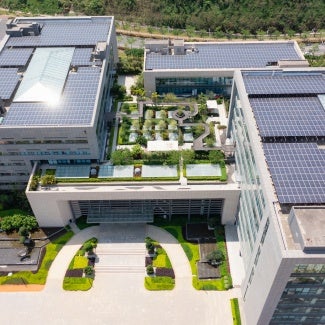ROI: The economic case for resilient design
The climate crisis has long-term economic consequences. Incorporating resilient design helps establish economic resilience to better withstand and recover from the unexpected.

Resilient, climate-adaptive design
The climate crisis underscores the need for a resilient and climate-adaptive built environment. Resilient design encompasses many possible scales of action, including structural approaches, nature-based approaches, as well as both facilities-based and non-facilities-based approaches.1 Architects have a critical role to play in creating a future where buildings can withstand sudden shocks and chronic stresses given that they design projects that transform the lives of their clients, building occupants, and surrounding communities. Architects can share with their clients the critical importance of incorporating resilience measures which will make the built environment more climate-adaptive and sustainable, and ultimately even increase its value.
Architects are also charged with protecting public safety. If a client’s project site or program challenges the tenets of responsible practice, the architect may choose not to compete for a project, help the client find a more appropriate site, or design a project with a smaller footprint. AIA’s Resilient Project Process Guide outlines three critical questions for architects to ask on every project:
- What are the hazard and climate projections for this site?
- What are the vulnerabilities, e.g. in what ways are people and built environment susceptible to adverse effects
- What design solutions address hazard and climate projections as well as vulnerability?
Resilient design economics
When thinking about the economic case for resilient design it is important to acknowledge the various scales of systems that architects and building owners are working within. Taking a systems-thinking approach, there are nested scales of the hazard impacts that are interlinked—from global to federal, regional, state, local, and individual—all impacting the value chain in which building owners, businesses, and architects are acting.2 Climate-related risks are also interconnected across socioeconomic and financial spheres and can play out over time horizons that stretch beyond traditional business planning or investment cycles.3
Literature review completed by University of Washington’s Integrated Design Lab for AIA in 2020.
The resilience of the built environment underpins the economic resilience of all organizations and communities; establishing economic resilience can buffer both from the worst economic outcomes when disasters strike. Architects can assist their clients in increasing the resilience of their built environment by helping them understand their vulnerabilities to shocks and stresses. This includes helping them increase their ability to avoid, withstand, or recover from the shock quickly.
Key establishing economic resilience talking points:
- Establishing economic resilience, whether in a local business or a regional economy, requires the ability to anticipate risk, evaluate how that risk can impact key economic assets, and build responsive adaptive capacity. Communities can develop goals, strategies, and actions to mitigate the effects of economic incidents and support long-term recovery efforts, including identifying and mitigating persistent economic challenges or deficiencies, preparing for disruptions by monitoring early warnings, establishing mechanisms that create flexibility, and promoting positive economic visions for the region.1
- Regional economic prosperity is linked to an area’s ability to prevent, withstand, and quickly recover from shocks to its economic base. Many definitions of economic resilience limit its focus on the ability to quickly recover from a disruption. However, in the context of economic development, economic resilience becomes inclusive of three primary attributes: 1) the ability to avoid the shock altogether, 2) withstand the shock, and 3) recover from it quickly.2
References
Architects can provide both direct client and greater social value with more resilient strategies and projects. Economic benefits can be calculated for each by looking at the direct benefit of the action, as well as associated benefits which are more difficult to quantify. Adaptive, or resilient design, encompasses approaches that span from nature and site-based, to building and infrastructure-focused, to management and operations interventions. There are already some existing useful toolkits that can help architects calculate the cost-benefit ratio of more resilient design:
- US government’s Federal Emergency Management Agency (FEMA) Benefit-Cost Analysis Toolkit
- The Smart Surfaces Coalition’s Cost-Benefit Analytic Engine
Key direct economic benefit talking points
- Direct benefits can be easily given a direct monetary value as an avoided loss, including reduced insurance premiums, based on the extent of property and assets that are protected by an action. Example metrics include square feet (ft²) of buildings, acres, or linear feet (LF) of shoreline protected.1
- According to the Multi-Hazard Mitigation Council, hazard mitigation lessens the financial impact of disasters when examined at a system level and society enjoys a positive benefit-to-cost ratio in all cases, ranging from 4:1 to 11:1 depending on the specific scenario studied.2
- Cities are connected by infrastructure networks, much of which is in need of urgent repair or replacement. Failing to address aging and deteriorating infrastructure is expected to cost the U.S. GDP as much as $10 trillion by 2039, costing more than 3 million jobs, and $2.4 trillion in exports over the next 20 years.3
References
- "Climate Change Planning Handbook Installation Adaptation and Resilience Final Report." Naval Facilities Engineering Command. 2017.
- "Natural Hazard Mitigation Saves 2019 Report." National Institute of Building Sciences. 2019.
- 2021 Infrastructure Report Card: A Comprehensive Assessment of America’s Infrastructure. 2021.
The collateral, ancillary, or co-benefits that may result from the direct effect of protecting specific features from loss can be considered indirect benefits. These benefits are more qualitative since assigning a monetary value to them can be a complex process. Actions such as building pedestrian and bike paths around wetlands can provide benefits including positive community and public relations, as well as added ecosystem services.1
Key indirect economic benefits talking points:
- Climate vulnerability and adaptive capacity of urban residents and communities are influenced by pronounced social inequalities that reflect age, ethnicity, gender, income, health, and (dis)ability differences.2
- Infrastructure Systems are interrelated and integrated. Essential infrastructure systems—such as water, energy supply, and transportation—will be increasingly compromised by interrelated climate change impacts. In urban settings, climate-related disruptions of services in one infrastructure system will almost always result in disruptions in one or more other infrastructure systems, compounding the impacts.3
- According to the Public Policy Institute of California, the carbon cost for waste removal and rebuilding of structures for flood-damaged structures is estimated to be roughly the same as flood-damaged structures are estimated to be roughly the same as for wildfires. Windstorms, Landslides, Tsunamis, and Volcanic activity also result in similar destruction and carbon emission results.4
References
- "Climate Change Planning Handbook Installation Adaptation and Resilience Final Report." Naval Facilities Engineering Command. 2017.
- "Fourth National Climate Assessment." U.S. Global Change Research Program. 2018.
- U.S. Climate Resilience Toolkit. 2022.
- "Floods in California." Public Policy Institute of California. 2017.
Keeping essential facilities and businesses open is the first priority in mitigating disasters. Avoiding disruptions among businesses has a positive economic impact including maintaining business continuity, avoiding loss of productivity, and attracting future economic investment. Disruptions to businesses can be devastating; direct negative impacts on business operations are cited as one of the top environmental sustainability and climate change issues that are already impacting organizations. Forward-looking resilient design contributes to positive economic resilience for communities, including the ability to avoid shocks, withstand shocks, or recover from shocks quickly. Depending on the hazard risk, resilience strategies are often code-required to provide continuity of operations for acute events.1
Key benefits of business continuity talking points
- Keeping essential facilities and businesses open and maintaining operational continuity during and after disasters is critical for resilience.2
- Economic benefits for resilience can consist of avoided interruptions to businesses (both asset destruction and lost income flows) and avoided lost productivity. Economic benefits can consist of avoided disruptions to jobs, incomes, and tax revenues both directly and indirectly linked through supply chains. The term economic revitalization is also used to show how some action alternatives provide resilience benefits that can restore and enhance an economy that would otherwise be disrupted and increase its ability to withstand future adverse events.3
- Investment in retrofits can reduce business interruption losses. Between 1989–1993, prior to the Northridge Earthquake, Anheuser-Busch completed a $17 million seismic retrofit in their Van Nuys, California facility. Their investment resulted in a total avoided cost of more than $750 million in losses in less than one year or a 4200% payoff on their retrofit investment. As a result of this experience, Anheuser-Bush has also completed a similar seismic retrofit project at its St. Louis brewery.4
- According to FEMA, 40% of small businesses fail to re-open after a disaster, either because they cannot afford to make repairs, or because of the revenue lost from being closed. And, on top of that another 25% of businesses will fail within one year. Three years after a disaster, 75% of businesses without a continuity plan will fail.5
- Negative impacts on business operations were cited as a top environmental sustainability and climate change issue that is already impacting or threatening organizations surveyed in a 2021 Deloitte Study, demonstrating that organizations are increasingly aware of how climate change will impact their core operations.6
References
- "Fourth National Climate Assessment." U.S. Global Change Research Program. 2018.
- Continuity Guidance Circular. Federal Emergency Management Agency National Continuity Programs. 2018.
- "Climate Change Planning Handbook Installation Adaptation and Resilience Final Report." Naval Facilities Engineering Command. 2017.
- Mid-America Earthquake Insurance workshop proceedings. Mid-America Earthquake Center. 1999.
- Ready Business Hurricane Toolkit. www.ready.gov. 2021.
- Bechert, Kyle. "Business’ views on environmental sustainability." Deloitte. 2021.
How to use these talking points
These talking points are intended for use in your conversations with clients, potential clients, civic leaders, vendors, contractors, and other architects. This helps demonstrate that architects are trusted partners in strengthening society, designing solutions, and transforming communities.
This is one chapter in AIA’s series ROI of High-Performance Design. Access the full resource below.
Explore programs and resources on incorporating resilience measures into designing for the future.
Access resources on hazard risk reduction development, design, and construction choices.
References
- "Climate Change Planning Handbook Installation Adaptation and Resilience Final Report." Naval Facilities Engineering Command. 2017.
- "Fourth National Climate Assessment." U.S. Global Change Research Program. 2018.
- "Task Force on Climate-related Financial Disclosures: Guidance on Risk Management Integration and Disclosures." TFCFD. 2020.



